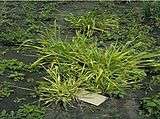Barley yellow dwarf
| Barley yellow dwarf | |
|---|---|
| Virus classification | |
| Group: | Group IV ((+)ssRNA) |
| Family: | Luteoviridae |
| Genus: | Luteovirus |
| Species: | Barley yellow dwarf virus |
Barley yellow dwarf is a plant disease caused by the barley yellow dwarf virus, and is the most widely distributed viral disease of cereals. It affects the economically important crop species barley, oats, wheat, maize, triticale and rice.
Biology
Barley yellow dwarf virus (BYDV) is a positive sense single-stranded RNA virus; the viron is not enveloped in a lipid coating.[1] The virus is transmitted by aphids, and the taxonomy of the virus is based on genome organisation, serotype differences [2] and on the primary aphid vector of each isolate.
The isolates and their major vectors (in parentheses) are:[3]
- Subgroup I
- MAV, a less severe strain carried by aphids (Grain aphid, Sitobion avenae), SGV (Schizaphis graminum), and PAV, a less severe strain carried by aphids (bird cherry-oat aphid, Rhopalosiphum padi, grain aphid, S. avenae, and others including rose-grain aphid, Metopolophium dirhodum).
- Subgroup II, called Cereal Yellow Dwarf Virus, however CYDV is now recognised as a separate species belonging to the Polerovirus genus of the Luteoviridae family
- RPV, the most severe strain carried by aphids (Bird cherry-oat aphid, Rhopalosiphum padi), RMV (Rhopalosiphum maidis)
Pathology

When aphids feed on the phloem of the leaf, the virus is transmitted to the phloem cells. Once inside the plant, the virus begins to replicate and assemble new virions. This process requires significant metabolic input from the plant, and causes the symptoms of barley yellow dwarf disease.
The symptoms of barley yellow dwarf vary with the affected crop cultivar, the age of the plant at the time of infection, the strain of the virus, and environmental conditions, and can be confused with other disease or physiological disorders. Symptoms appear approximately 14 days after infection. Affected plants show a yellowing or reddening of leaves (on oats and some wheats), stunting, an upright posture of thickened stiff leaves, reduced root growth, delayed (or no) heading, and a reduction in yield. The heads of affected plants tend to remain erect and become black and discoloured during ripening due to colonization by saprotrophic fungi. Young plants are the most susceptible.

The virus is transmitted from the phloem when the aphid feeds. When the aphid feeds, virions go to the aphid's hind gut, the coat protein of the virus is recognised by the hindgut epithelium, and the virion is allowed to pass into the insect's hemolymph, where it can remain indefinitely, but the virus cannot reproduce inside the aphid.[4] The virus is actively transported into the accessory salivary gland to be released into salivary canals and ducts. The virus is then excreted in the aphid saliva during its next feeding.
The host range of BYDVs consists of more than 150 species in the Poaceae; a large number of grasses both annual and perennial are alternate hosts to BYVD and can serve as reservoirs of the virus.
Sources and spread
There are two main sources by which a cereal crop might be infected
1. By non-migrant wingless aphids already present in the field and which colonise newly-emerging crops. This is known as "green-bridge transfer".
2. By winged aphids migrating into crops from elsewhere. These then reproduce and the offspring spread to neighbouring plants.
Effect on yield
This is variable since it depends on viral strain, time of infection and rate of spread. Most severe losses are from early infections and can be as high as 50%.
Control
"Green bridge" sources must be ploughed in as early as possible. Alternatively, a desiccant herbicide should be applied 10 days prior to cultivation. Insecticide sprays may be used at crop emergence.
Drilling dates prior to mid-October favors attacks from winged migrant aphids. However, yield penalties may be experienced from late drilling. Insecticide sprays in this instance are therefore aimed at killing the aphids before significant spread can occur.
Products used
Synthetic pyrethroid insecticides
References
- ↑ International Committee on the Taxonomy of Viruses. 2002. Barley yellow dwarf virus
- ↑ Ali, M, Tahir, M, Hameed, S, Ashraf, M 2013. Coat protein based molecular characterization of Barley yellow dwarf virus isolates identified on oats in Pakistan.Acta Virologica 57(3):383-385
- ↑ Miller, W.A. and Rasochova, L. 1997. Barley yellow dwarf viruses. Annual Review of Phytopathology 35:167-190
- ↑ Gray, S. and Gildow, F.E. 2003. Luteovirus-aphid interactions Annual Review of Phytopathology 41:539-566